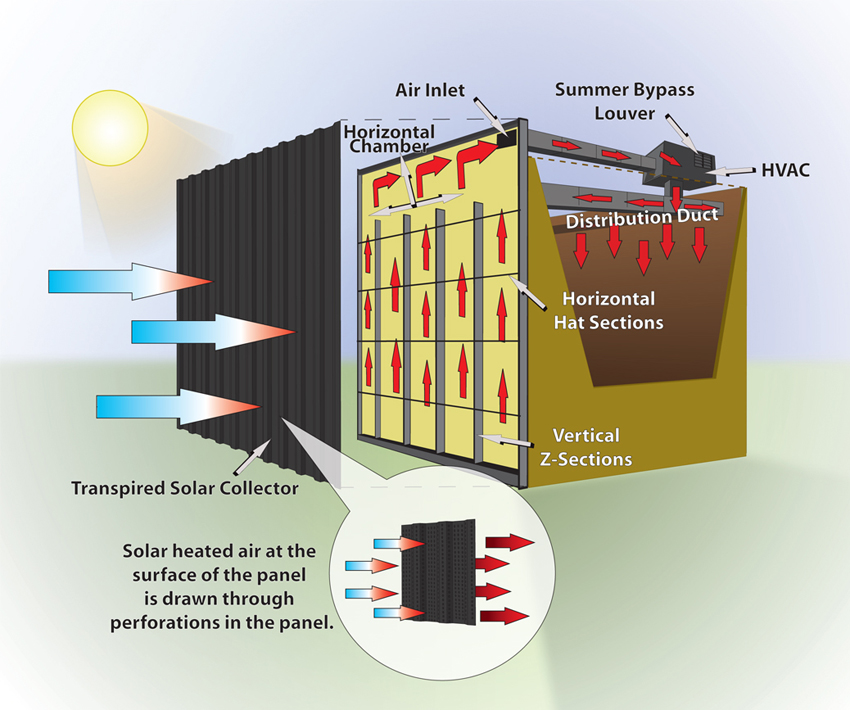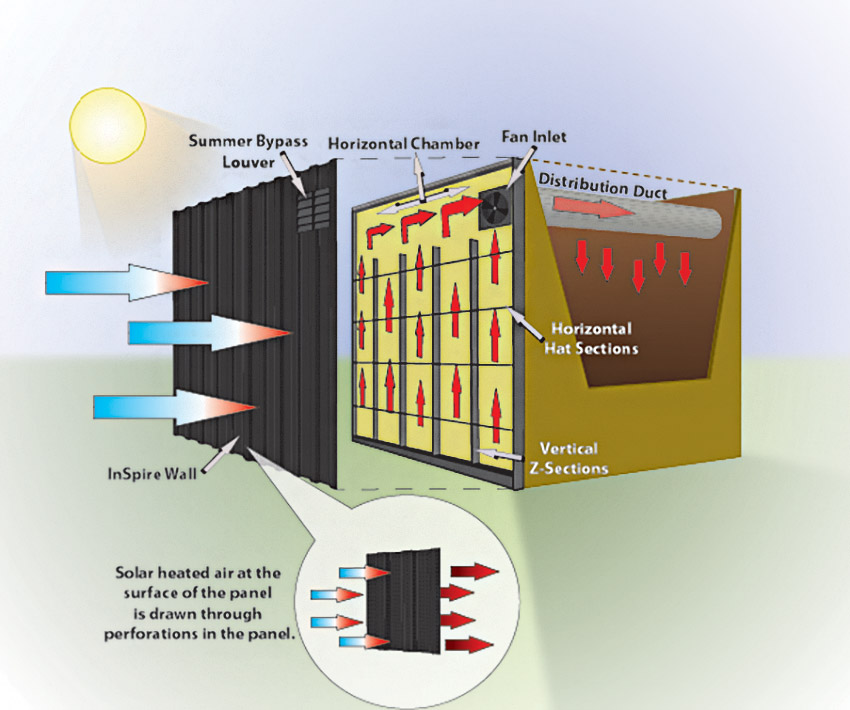Innovative Technologies for Sustainable Building Envelopes
Connections
In an industrial application, solar-heated air is supplied directly to the building via a perforated flexible duct. In open-ceiling spaces, buildings, or halls, ducting destratifies ceiling heat, thereby reducing heating loads.
In a high-occupancy building, such as an office, school, or medical facility, the solar-heated air is ducted directly to the HVAC air handler, thus reducing loads on the conventional heater. Additionally, the system can be connected to an air makeup or heat-recovery unit.
As a versatile technology, the transpired solar-collector system works with most mechanical designs, making it appropriate for both new and retrofit applications. An HVAC engineer should consider solar air as simply an additional heat source that needs to be managed and controlled in an optimal way.
Heating Season: Industrial Application
In cooler months, the role of the heating system is to compensate for the thermal losses through the building’s envelope. Heating loads become very important when ventilation outside air must be heated. This is where transpired solar collectors come into play.
The use of solar-collector panels facilitates healthy indoor air quality, reduces heating consumption for ventilation, and can lower heating costs by $1.50–$5.50 per square foot of panel per year. Reduction is dependent upon several factors, including displaced fuel cost, ventilation schedule, and color of the transpired solar-collector panels.

This shows the system for a high-occupancy application, such as a school or office building. In this case, the warmed air is ducted to the building’s regular air-handling system, usually a makeup air unit or rooftop air handler.

This shows an industrial application in the heating season where the warmed outside air is brought directly into the building via a perforated distribution fabric air duct attached to the stand-alone fan. From there, the warm air is either distributed into the building when needed or sent back into the environment by a bypass damper if warm air is not required at the time.
Cooling Season: Daytime and Nighttime
Solar-collector panels help to reduce the cooling load in the summer months.
During cooling season, the solar-collector panels act as a sunscreen, preventing the sunshine from striking the building wall and keeping the wall cooler.
Since the building does not require heat at this time of year, the warm air enters the space behind the panel and is vented at the top by natural convection. During cool summer nights, the intake fan pulls outside air through the perforated wall and past the open bypass damper, bringing cooler outdoor air inside.
Heat Stratification
Another benefit of a transpired solar-collector system is heat destratification, which is the process of mixing the internal air in a building to get rid of stratified layers of air and thus achieve equal temperature throughout the inside of the building envelope.
Why is this significant? Thermal layering of air creates significant heating inefficiencies, especially in buildings with high ceilings. Naturally the warmest layer of air is near the ceiling, but so are the exhaust fans. These exhaust fans create a negative pressure near the ceiling, causing cold air to infiltrate the building near ground level while the warmest air gets exhausted out of the building. This is a waste of energy.
By drawing warm air through the transpired solar-collector wall and into the distribution duct, the process is reversed. In other words, it is destratified.
Increasing the internal air pressure toward the ceiling forces the solar-heated air to move toward floor level. This can be particularly noticeable when doors are opened, especially large roll-up cargo doors.

While the most commonly used colors for transpired solar panels are higher-efficiency black or dark brown for their heat-absorption properties, many other colors can also be specified.
Design Flexibility
Because of the simple nature of the technology, transpired solar-collector systems offer robust design flexibility, so the designer is not locked into a particular orientation that may not fit the design aesthetic. The panels may be oriented horizontally or vertically and feature mitered corners and concealed fasteners. To meet a range of aesthetic objectives, solar-collector panels come in a wide variety of colors and profiles.
Naturally, the most commonly used colors are black or dark brown, as they work best for heat absorption. However, many other colors can be specified for these systems, with the caveat that they will produce a slightly lower BTU or heat output.
A complete line of trims is generally available in matching colors, gauges, and finishes, or as specified, depending on the manufacturer. The panel system can integrate with windows and doors, so an unbroken wall surface is not necessary. Transpired walls can be designed for radius walls as well.
Costs and Rebates
Generally, the payback period for a commercial application of a transpired solar-collector system ranges from zero to eight years in new projects and three to 10 years in retrofit applications. However, that time frame varies a great deal based primarily on the cost of fuel for the building’s primary heat source.
A favorable tax environment enhances the financial feasibility of transpired solar-collector technology. For commercial projects, a 26 percent federal tax credit is available for solar space heating projects placed in service through December 31, 2020, and a 22 percent federal tax credit is available for systems placed in service through December 31, 2021.3
Plus, some states offer their own tax incentives, rebates, grants, and loans (visit www.dsireusa.org for more information).
Sustainability
Transpired solar-collector systems have green building benefits, including:
- Convert up to 80 percent of the sun’s radiation into non-polluting warm air
- Recapture heat loss through building walls
- Provide insulating effect on building inner wall
- Utilize hot stratified air trapped at ceilings
- Lower the temperature of air exhausted through the roof
- Reduce energy consumption and greenhouse gas emissions
- Shield the inner wall from direct sunlight during summer
- Provide a cost-effective way to meet code requirements for ventilation
- Deliver improved indoor air quality and reduce the risk of sick building syndrome
- Require virtually no maintenance
- May contribute toward LEED certification credits
LEED v4: Potential Contribution of Transpired Solar Collector
- Integrative Process Credit (1 point)
- Minimum Energy Performance (prerequisite)
- Optimize Energy Performance (up to 18 points)
- Renewable Energy Production (up to 3 points)
- Building Life-Cycle Impact Reduction (up to 5 points)
- Thermal Comfort Credit (1 point)
- Innovation Credit (up to 5 points)









